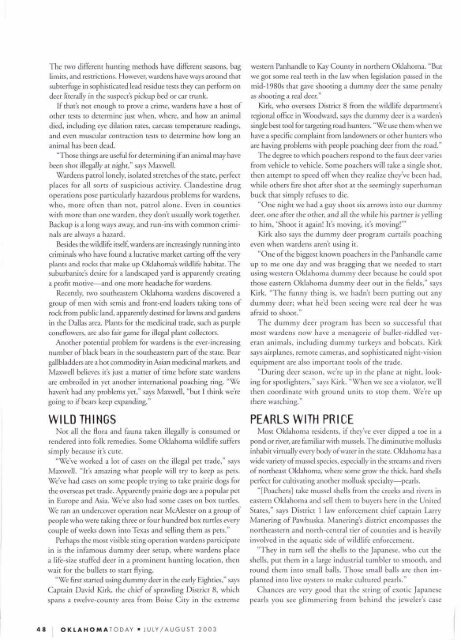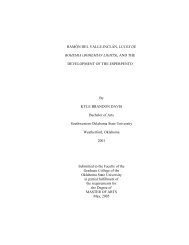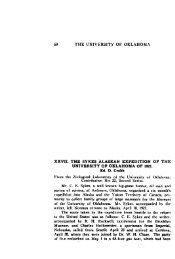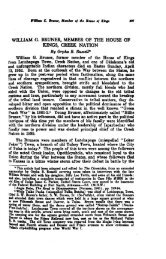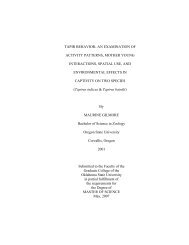Oklahoma Today July-August 2003 Volume 53 No. 4
Oklahoma Today July-August 2003 Volume 53 No. 4
Oklahoma Today July-August 2003 Volume 53 No. 4
You also want an ePaper? Increase the reach of your titles
YUMPU automatically turns print PDFs into web optimized ePapers that Google loves.
The two different hunting methods have different seasons, bag<br />
limits, and restrictions.However, wardenshaveways around that<br />
subterfugein sophisticatedlead residue tests theycan perform on<br />
deer literally in the suspect'spickup bed or car trunk.<br />
If that's not enough to prove a crime, wardens have a host of<br />
other tests to determinejust when, where, and how an animal<br />
died, including eye dilation rates, carcass temperature readings,<br />
and even muscular contraction tests to determine how long an<br />
animal has been dead.<br />
"Thosethings areuseful for determiningif an animalmay have<br />
been shot illegallyat night," says Mawvell.<br />
Wardens patrol lonely, isolatedstretches of the state, perfect<br />
places for all sorts of suspicious activity. Clandestine drug<br />
operationspose particularlyhazardous problems for wardens,<br />
who, more often than not, patrol alone. Even in counties<br />
with more than one warden, they don't usually work together.<br />
Backup is a long ways away, and run-ins with common criminals<br />
are always a hazard.<br />
Besides thewildlifeitself,wardensareincreasinglyrunning into<br />
criminalswho have found a lucrative market carting off the very<br />
plants and rocks that make up <strong>Oklahoma</strong>'s wildlife habitat. The<br />
suburbanite's desire for a landscapedyard is apparently creating<br />
a profit motive-and one more headache for wardens.<br />
Recently, two southeastern <strong>Oklahoma</strong> wardens discovered a<br />
group of men with semis and front-end loaders taking tons of<br />
rock from public land, apparentlydestined forlawns andgardens<br />
in the Dallas area. Plants for the medicinal trade, such as purple<br />
coneflowers, are also fair game for illegal plant collectors.<br />
Another potential problem for wardens is the ever-increasing<br />
number of black bears in the southeastern part of the state. Bear<br />
gallbladdersareahot commodityinAsian medicinal markets, and<br />
Maxwell believes it's just a matter of time before state wardens<br />
are embroiled in yet another international poaching ring. "We<br />
haven't had any problems yet," says Maxwell, "but I think we're<br />
going to if bears keep expandmg."<br />
WILD THINGS<br />
<strong>No</strong>t all the flora and fauna taken illegally is consumed or<br />
rendered into folk remedies. Some <strong>Oklahoma</strong> wildlife suffers<br />
simply because it's cute.<br />
"We've worked a lot of cases on the illegal pet trade," says<br />
Maxwell. "It's amazing what people will try to keep as pets.<br />
We've had cases on some people trying to take prairie dogs for<br />
the overseas pet trade. Apparentlyprairie dogs are a popular pet<br />
in Europe and Asia. We've also had some cases on box turtles.<br />
We ran an undercover operation near McAlester on a group of<br />
people who were taking three or fourhundred box turtles every<br />
couple of weeks down into Texas and selling them as pets."<br />
Perhaps the most visible sting operationwardens participate<br />
in is the infamous dummy deer setup, where wardens place<br />
a life-size stuffed deer in a prominent hunting location, then<br />
wait for the bullets to start flying.<br />
"We firsrstarted using dummydeer in the earlyEighties," says<br />
Captain David Kirk, the chief of sprawling District 8, which<br />
spans a twelve-county area from Boise City in the extreme<br />
western Panhandleto Kay County in northern <strong>Oklahoma</strong>. "But<br />
we got some real teeth in the law when legislation passed in the<br />
mid-1980s that gave shooting a dummy deer the same penalty<br />
as shooting a real deer."<br />
Kirk, who oversees District 8 from the wildlife department's<br />
regional office in Woodward, says the dummy deer is a warden's<br />
singlebest tool for targetingroadhunters. "We use them whenwe<br />
have a specificcomplaintfrom landownersor other hunters who<br />
are having problems with people poaching deer from the road."<br />
The degreeto which poachers respond to the faux deer varies<br />
from vehicle to vehicle. Some will take a single shot,<br />
then attempt to speed off when they realize they've been had,<br />
while others fire shot after shot at the seemingly superhuman<br />
buck that simply refuses to die.<br />
"One night we had a guy shoot six arrows into our dummy<br />
deer, one after the other, and all the while his partner is yelling<br />
to him, 'Shoot it again! It's moving, it's moving!"'<br />
Kirk also says the dummy deer program curtails poaching<br />
even when wardens aren't using it.<br />
"One of the biggest known poachers in the Panhandlecame<br />
up to me one day and was bragging that we needed to start<br />
using western <strong>Oklahoma</strong> dummy deer because he could spot<br />
those eastern <strong>Oklahoma</strong> dummy deer out in the fields," says<br />
Kirk. "The funny thing is, we hadn't been putting out any<br />
dummy deer; what he'd been seeing were real deer he was<br />
afraid to shoot."<br />
The dummy deer program has been so successful that<br />
most wardens now have a menagerie - of bullet-riddled veteran<br />
animals, including dummy turkeys and bobcats. Kirk<br />
says airplanes, remotecameras,and sophisticated night-vision<br />
equipment are also important tools of the trade.<br />
"During deer season, we're up in the plane at night, looking<br />
for spotlighters," says Kirk. "When we see a violator, we'll<br />
then coordinate with ground units to stop them. We're up<br />
there watching."<br />
PEARLS WITH PRICE<br />
Most <strong>Oklahoma</strong> residents, if they've ever dipped a toe in a<br />
pond or river, arefamiliarwith mussels.The diminutivemollusks<br />
inhabitv idy everybodyofwater in thestate. <strong>Oklahoma</strong>has a<br />
widevariety of mussel species, especially in the streams and rivers<br />
of northeast <strong>Oklahoma</strong>, where some grow the thick, hard shells<br />
perfect for cultivating another mollusk specialty-pearls.<br />
"[Poachers] take mussel shells from the creeks and rivers in<br />
eastern <strong>Oklahoma</strong> and sell them to buyers here in the United<br />
States," says District 1 law enforcement chief captain Larry<br />
Manering of Pawhuska. Manering's districr encompasses the<br />
northeastern and north-central tier of counties and is heavily<br />
involved in the aquatic side of wildlife enforcement.<br />
"They in turn sell the shells to the Japanese, who cut the<br />
shells, put them in a large industrial tumbler to smooth, and<br />
round them into small balls. Those small balls are then implanted<br />
into live oysters to make cultured pearls."<br />
Chances are very good that the string of exoticJapanese<br />
pearls you see glimmering from behind the jeweler's case<br />
48 1<br />
OKLAHOMATODAY JULY/AUGUST <strong>2003</strong>


